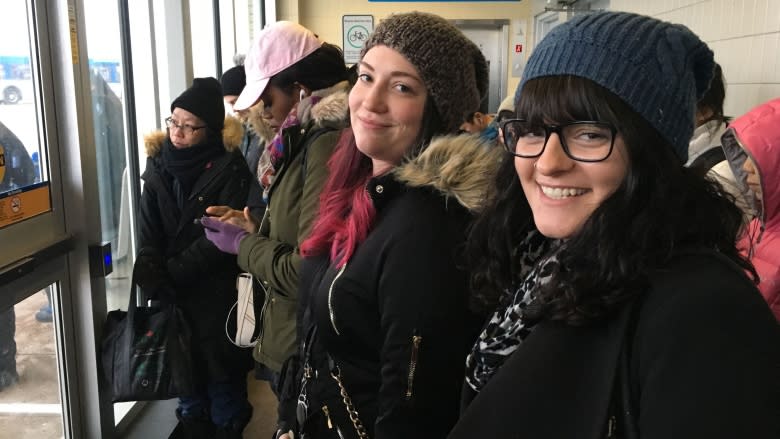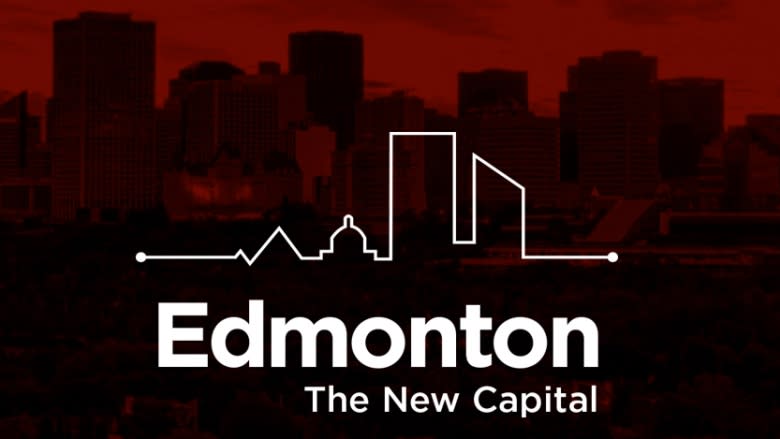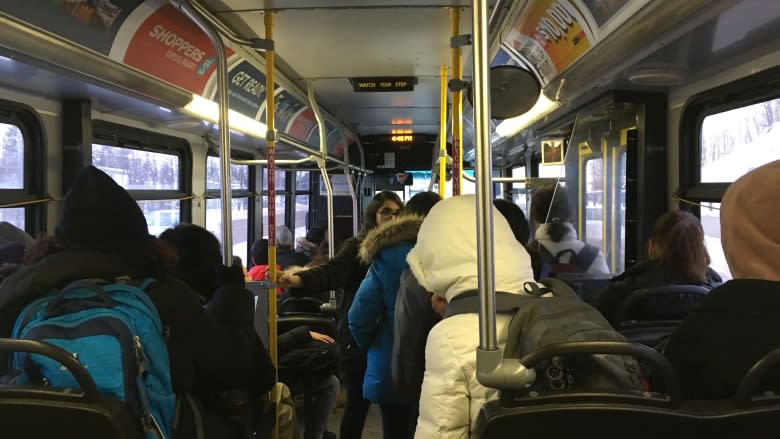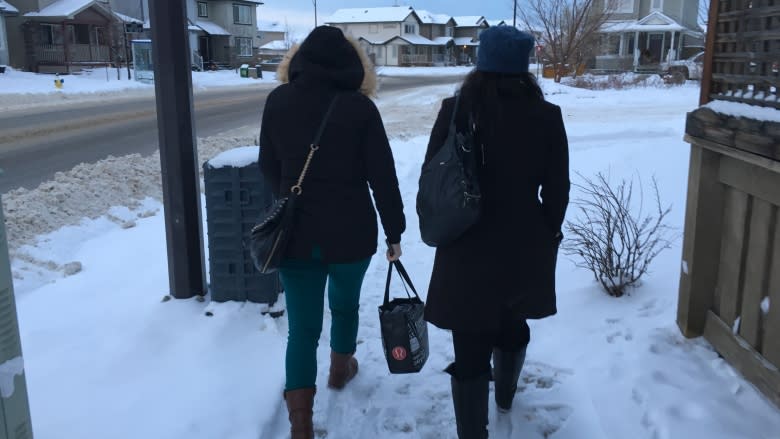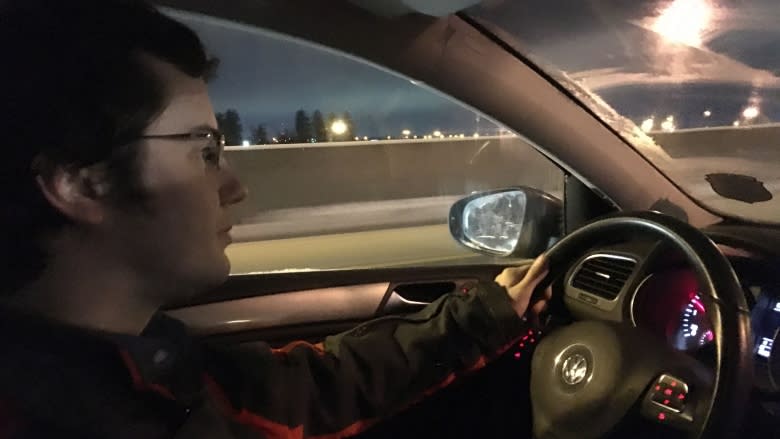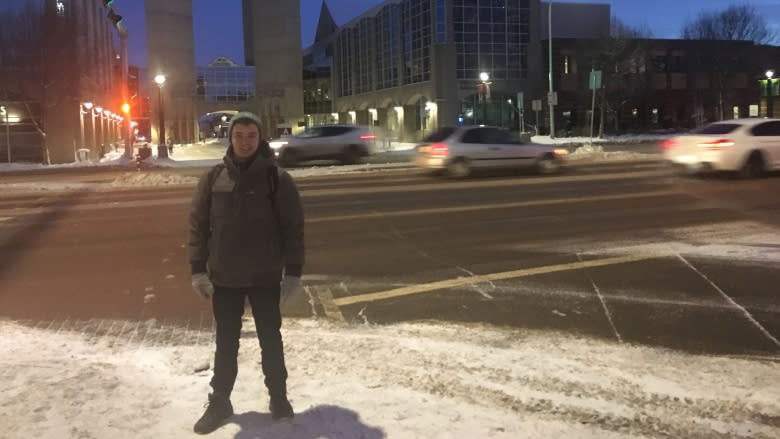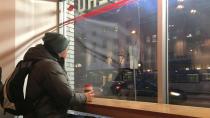City commuting: It's not the destination, it's the journey
Edmonton: The New Capital is a special series taking the pulse of the city. From Terwillegar to Castle Downs, CBC journalists are talking to people about how Edmonton is changing and what it means for the future.
Commuting can be one of the most stressful parts of your day. Or it can be one of the best.
As the city invests in better roads, more bike lanes and an expanded public transit system, the way we commute in Edmonton is evolving. CBC News joined four Edmontonians on their daily journey, to see how they get around and how it affects their day.
What did we find? Edmontonians who embrace public transit despite its flaws, or look for ways to make a dreaded drive more tolerable, or reward themselves with a treat at the end of their commute. All are trying to stay warm during the cold winter months and get where they're going on time.
ETS bus and LRT
On a snowy Monday in January, Robyn Hudson and Brittany Baillie are rushing down the steps of Corona LRT station. They're trying to make the 4:15 p.m. train before the rush hour crowds arrive.
The roommates work at a call centre downtown and live in a Terwillegar apartment in the city's southwest.
The train arrives on time and the three of us find seats in one of the middle cars. With the exception of the doors swishing open and closed, it's a quiet 20-minute ride to Century Park. Around us, commuters are reading, scrolling through their phones or listening to music to pass the time.
Hudson and Baillie, both in their 20s, hail from the smaller communities of Beaumont and Leduc and they value having an option to take public transit versus driving to get around. The pair both hold monthly ETS transit passes; with the exception of weekends and running errands, they try to avoid driving altogether.
Some of Hudson's appreciation for Edmonton's public transit system stems from living in China for a year.
"It was a nightmare in China, there were so many people. This is a godsend compared to that," she says.
In China, she explains, public transit was very clean — and very crowded. "You couldn't move shoulder to shoulder. It didn't matter what time you were on the train, that's just how many people were on it.
"Edmonton is still the easiest transportation I've had to take. Maybe not the most straightforward at times, but it does its job, usually."
As soon as the train doors open at Century Park, Hudson and Baillie charge into the station and race across the pedway down to the bus stop. They're hoping to catch bus 35, which drops them off closer to home than bus 37.
We wait inside the heated shelter, huddled shoulder-to-shoulder with dozens of other commuters, until the 35 arrives a couple of minutes later.
Settling into our seats at the back of the bus, Baillie says buses don't always come on time and in the winter, it can get cold waiting for transit that is delayed by weather. There is an app, ETS Live To Go, but it's slow to update with the latest information on delays, Baillie says.
So she makes a point of arriving five minutes early for buses.
"It's not fun chasing a bus and have them not opening the doors for you," she says. "They don't wait, even if you're right out there."
Twenty minutes later, we reach our stop. Stepping carefully through windrows and snowy sidewalks, we're in their apartment in about five minutes — 5:05 p.m.
Despite the length of their commute and the hassle of transfers, Hudson and Baillie say it can be a peaceful part of their day — as long as there aren't delays.
"I think this, for what I need right now, works really well for me," Baillie says.
Total commute: 50 minutes
Pros: More relaxed than driving, fairly efficient, chance to listen to music or read, can commute together, affordable.
Cons: Delays, trains and buses can be crowded and noisy, waiting in the cold, ETS transit app not always reliable.
Driving the Anthony Henday
Michael Ross gets into a frozen car at 7 a.m. on a Tuesday. He cranks the heat and pulls out of his parking lot.
He'd rather be taking the train.
He lives just off 111th Street near Anthony Henday Drive, a condo he bought to be able to take the LRT to his engineering job downtown. But he lost that job about a year ago and his new one is on St. Albert Trail and 146th Street. Driving there takes about 30 minutes. Public transit, he estimates, would take three times as long — and he's not even sure how he'd do it.
"Before, I was able to just kind of get on the train and sit down, read a book or listen to music or just sort of doze," he says. "But now I have to sort of stay focused. It's a little bit more annoying, it's obviously colder."
He's figured out that leaving any later than 7 a.m. means hitting a lot more traffic. He peers through his frosty window as he merges westbound onto the Henday in the dark.
Road conditions are good this morning, but Ross says it can be precarious after a snowstorm. Sometimes he sees vehicles in the ditch.
We soon hit the first bottleneck, at a bridge over a ravine about one kilometre before the exit to Cameron Heights Drive. This is a frequent trouble spot, Ross says, where traffic can sometimes come to a standstill. Today, after a brief slow-down, things pick up quickly.
There isn't much Ross likes about his commute, and it's costing him. When he switched jobs, he had to let his insurance company know he'd be driving a lot more. Now, he pays around $200 per year more on car insurance, on top of about $100 each month to gas up his Volkswagen Golf — almost the same price as the $97 monthly ETS transit pass.
Ross tries to make good use of his commuting time by listening to audiobooks from the Edmonton Public Library, or podcasts like Cortex, Hello Internet, Hardcore History, and Quirks & Quarks.
But he'd rather be listening to these on the train, and has considered moving to be closer to his job.
"In a perfect world, we could have a fun, more expansive rapid transit system and that would be great," he says.
"I understand the transit system being the way it is, but even if public transit took 45 minutes instead of driving taking half an hour, that would probably be maybe a break-even point for me."
We arrive at another bottleneck, this time at the Yellowhead Highway exit. This one also clears before we come to a full stop.
Ross says Edmonton drivers are, for the most part, pretty good to commute with. Though he wishes drivers could all agree on certain rules of the road, like zipper merging.
Exactly 30 minutes after we left his home, Ross pulls into his parking stall just off St. Albert Trail. It's an industrial area, and the air smells like freshly baked bread from a nearby factory.
Total commute: 30 minutes
Pros: No waiting for trains or buses, flexibility to run errands.
Cons: Can be stressful, road conditions vary, increased insurance and gas costs.
Walking downtown
Aidan Wakefield pulls on a heavy jacket, thick gloves, a toque and hiking boots. It's -24 degrees at 7:30 on a Wednesday morning. The key to this commute, he says, is to not have any exposed skin.
Wakefield works at a software company downtown and walks from his apartment in Kingsway, near the Royal Alexandra Hospital.
He used to live in Ritchie, from where he would drive to work every day. This is a chillier expedition but he prefers it.
We head south on the sidewalks lining 106th Street. Wakefield is energetic but the residential streets are quiet. For several blocks, we see no one and hear nothing except for the squeak of the snow beneath our boots. The sidewalks are usually shovelled, Wakefield says, but if he thinks it might be icy, he'll leave a bit earlier.
"Honestly, this is a pretty quiet morning. It's a nice time to kind of reflect on things," Wakefield says. "This is the easiest commute to work in the world."
When we get to 107th Avenue, we stop and look in both directions. There are no crossing lights here and making eye contact with drivers is a must, Wakefield says as the traffic slows for us to cross.
As we approach MacEwan University, the early morning sun shines off Rogers Place and our breath begins freezing to our hair and eyelashes. We pass a cyclist in a bike lane, bundled up in layers of winter gear and wearing ski goggles.
Although Wakefield bikes in the summer, he's not keen for winter cycling. Walking, he says, is cold enough.
"Investing in some good winter wear if you're a Canadian is vital," he says.
"Wear a pair of long johns. They're not your dad's long johns anymore, they're not the gray, folded old school ones. Definitely worth it."
We turn left onto Jasper Avenue. With a few minutes to spare before work, we stop at a coffee shop across the street. He orders a mocha and eyes the pastries.
He takes a seat at the window and watches the traffic go by. Wakefield says on cold days like this, he's figured out how to time the light so he can walk out the door and head straight across the street to work.
As we head into his office, Wakefield says he loves the convenience of not having to worry about the expense of parking downtown.
"There's no sense grudging your commute if you're going to have to do it every day," he says. "Pick a route that works for you. Enjoy it.
"I see no sense to starting your day on a stressful note."
Total commute: 30 minutes, including coffee stop.
Pros: Cheapest option, adds exercise to the day, no worries about parking or traffic, low stress.
Cons: Weather can make the commute treacherous.
Read more stories from Edmonton: The New Capital on cbc.ca/edmonton or listen to CBC Radio One, 93.9 FM/740 AM.

